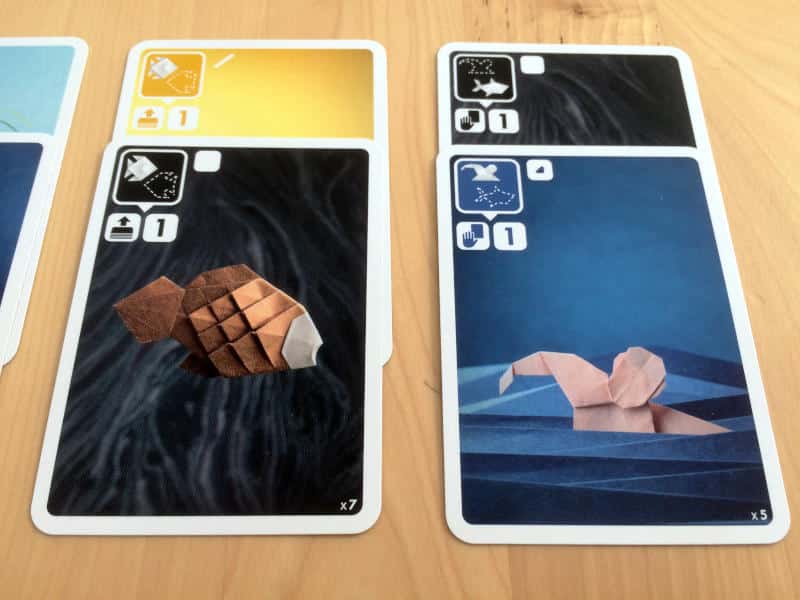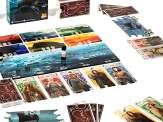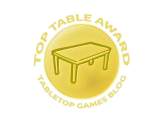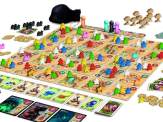| Release Date: 2022 | Players: 2-4 |
| Designer: Bruno Cathala, Théo Rivière | Length: 30-45 minutes |
| Artist: Lucien Derainne, Pierre-Yves Gallard | Age: 10+ |
| Publisher: Bombyx | Complexity: 1.5 / 5 |
| Plastic (by weight): <1% | Air (by volume): 15% |
The sea was calm and the sun was shining. The sandy beach stretched for miles, strewn with shells, some occupied by hermit crabs. In the distance, I could see a few small boats. Underneath the long abandoned lighthouse, there was a small colony of penguins. As I closed my eyes and dozed off, I dreamt of fish and merpeople. My mind was thinking about Sea Salt & Paper by Bruno Cathala and Théo Rivière from Bombyx.
The introduction is a bit dreamy and tries to reflect the lovely origami art represented on the cards of this quick, family-friendly set collection card game. The artists Lucien Derainne and Pierre-Yves Gallard have realized a really wonderful style that somehow brings this rather abstract game to life. Everything is made up of origami, whether it’s merpeople, fish, crabs, boats or anything else. It’s just gorgeous.
Point Salad and Card Draws
Sea Salt & Paper‘s scoring is really interesting. You score based on sets of cards, as long as you have at least a pair. Some cards score more points for more cards. Others only score for a pair. You also score based on card colour. There is even the possibility of getting points for every single card of a certain type. It sounds very confusing, but becomes clear after a round or two.
The way you draw cards in Sea Salt & Paper is also very interesting. There is a draw deck and two face-up discard piles. On your turn, you either draw two face-down cards from the deck, look at them, keep one and discard the other onto one of the two discard piles. That way the other players won’t know what you’ve chosen, but it also means that sometimes you have to make a tough choice between two really good cards. You can only keep one of those two cards, meaning the other will become available to the next player. That’s because the other option on your turn is two take one of the face-up cards from either of the two discard piles, instead of drawing from the face-down deck. However, doing that means everyone else knows what you took.
It’s a really simple mechanism, but often a really tough choice. It also introduces a memory element to the game. Normally, I’m not fond of memory elements in games, especially if the information was previously public knowledge. Yet, in Sea Salt & Paper I actually quite like it. You don’t necessarily have to remember every card that was discarded or every card that other players took. There will be key cards you want to remember, which means it’s not too much of a burden.
Extra Actions
Already, Sea Salt & Paper is a bit different to other card games. However, there is something else that sets the game apart from other set collection games. There are certain cards that you want to collect as pairs. These pairs will only score you one point, but if you play them, you get an extra action. That could be another turn, being able to choose one of the discard piles and take any card from it into your hand or draw the top card from the face-down deck. You can even steal a card from another player, which introduces a bit of extra player interaction.

Get yourself a wooden Tabletop Games Blog dice tray.
Each tray is the perfect size to roll your dice, and with the soft mat, it’s really quiet, while the wooden frame makes it wonderfully sturdy.
When you first play Sea Salt & Paper, you probably play these pairs straight away. It seems to make sense. Yet, the more you play the game, the more you realize that hanging onto a pair can be more beneficial. Timing when you get the extra action can give you a crucial edge over the other players. Get it right and you can sometimes get a card that gives you another pair which gives you another extra action. It is possible to chain several extra actions together and have a super turn.
However, hanging onto cards is also risky. If another player gets the action that allows them to steal cards, you risk losing the vital pair you kept back to play on your next turn. It can ruin your plans, but it is often worth the risk.

Push Your Luck
There is also a small amount of push-your-luck in Sea Salt & Paper. When a player has at least 7 points’ worth of cards, irrespective of whether they are in hand or in front of them, they can decide to end the round. They now have a choice: simply stop or push for the chance of gaining a huge lead.
Choosing stop means everyone adds up their points and adds those to their running total.
If you decide to push your luck instead, which is called “last chance” in Sea Salt & Paper, you immediately reveal all of your cards. Then everyone else gets one more turn, during which they might play more of their extra action pairs, before revealing their hand. Once everyone has had their extra turn, everyone adds up their points. If the player who called “last chance” still has the most points, they get a so-called “colour bonus”.
That means they get one point for each card of whatever colour they have the most of. So if they have three yellow cards, two black and two blue, they get three points for the three yellow cards. That’s on top of their normal point score. That’s not all though. All the other players only score their colour bonus. That means you can easily score 10 or more points, while everyone else only scores three or four. That will make a huge difference to the running totals.
If the last-chance player ends up not having more points than everyone else, they only get their colour bonus, while everyone else gets their normal card score, without an extra colour bonus though. So it can be devastating if you don’t win your last-chance bet.
Sea, Salt and Paper Fun
The game continues like this until one player has at least a certain number of points, based on player count. Whoever then has the most points wins. It’s quite simple, but you do have to keep track of running totals and see where everyone is at. The further you fall behind, the more pressure is on you to either call an early stop or risk it with a last chance. It can get very tense.
Like with many games, the more you play Sea Salt & Paper, the better you get at it. It doesn’t take too long to get the hang of it though. After a game or two, most people will start to try out different strategies and tactics. There is also a certain amount of randomness, due to how the cards come out, but you have some control over it through the two open discard piles that you can draw from and even when you draw from the deck, you get to choose one of two cards.
There are also a lot of different ways of winning in the game. So you do have to play according to what cards you get. Sometimes most of your points will come from sets, other times from your colour bonus and if you get lots of pairs, your scoring potential can come from that.
I would say Sea Salt & Paper can be played with younger children, who will pick it up quite quickly. They just might need a little help with the scoring. It’s also just a deck of cards, so it fits easily into a handbag or backpack. It doesn’t take up too much space on the table, so can easily be played while out and about.
I really enjoy this game and it has been popular among my friends as well. I suggest you give it a go yourself and see where Sea Salt & Paper takes you.
Keeping the blog running takes time and resources. So if you can chip in, that would be amazing.
Useful Links
- Sea Salt & Paper: https://studiobombyx.
com/ en/ jeu/ sea-salt-paper/ - Rulebook: https://studiobombyx.
com/ assets/ SSAP_ rulebook_ EN-3. pdf - Bombyx: https://studiobombyx.
com/ en/ - BGG listing: https://boardgamegeek.
com/ boardgame/ 367220/ sea-salt-paper
Videos
Transparency Facts
I feel that this review reflects my own, independent and honest opinion, but the facts below allow you to decide whether you think that I was influenced in any way. Please also read my Ethics Statement for more information.- I played a friend's copy of the game.
- At the time of writing, I have not received financial support from the publisher or anyone working on their behalf.
Audio Version
Intro Music: Bomber (Sting) by Riot (https://www.
Sound Effects: bbc.co.uk – © copyright 2023 BBC
The following music was used for this media project:
Music: Ailien Lullaby by Mikael Hellman
Free download: https://filmmusic.io/song/5721-ailien-lullaby
License (CC BY 4.0): https://filmmusic.io/standard-license





